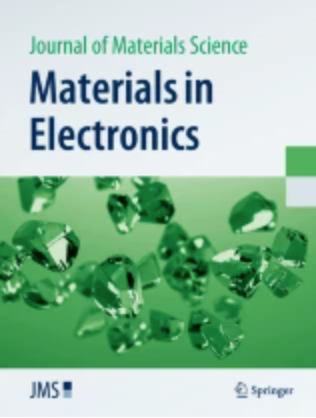空穴掺杂多晶简单钙钛矿锰矿La0.6−xCaxSm0.1Ba0.3MnO3 (x = 0.0和0.1)的磁阻和电响应特性
摘要
采用固相反应法制备了掺杂孔洞的锰酸盐\({\text{La}}_{\left(0.6-x\right)}{\text{Ca}}_{x}{\text{Sm}}_{0.1}{\text{Ba}}_{0.3}{\text{MnO}}_{3}\)(分别为\(x=0.0\)和0.1)。研究了材料的结构、微观结构、电输运、磁输运和电阻温度系数(TCR)等性能。x射线衍射(XRD)分析表明,两种化合物均为具有Imma空间基团的正交晶型结构,未检测到二次相。与未掺杂的样品相比,掺钙样品的晶粒明显更小、更均匀。电阻率测量显示,在\(221 K\)附近发生金属-绝缘体转变,ca掺杂后转变温度降低。低温下的磁阻(MR)值较大,达到23.37% for the undoped sample and \(23.7\%\) for the Ca-doped sample at \(290 K\). The temperature dependence of resistivity exhibited both intrinsic and extrinsic contributions to magnetoresistance (MR), with a peak MR of 23.7% for the Ca-doped sample and \(23.37\%\) for the undoped one at low temperatures. The TCR curve showed a peak of \(1.78 \%{K}^{-1}\) at room temperature, indicating significant temperature-dependent resistance changes. Low-temperature resistivity was described with a combination of residual resistivity, weak localization, and electron–electron interactions, whereas the high-temperature behavior is well described by adiabatic small polaron hopping. These results bring out the complexity in the interrelation between structural changes and magnetotransport properties and emphasize the role of Ca-doping in tuning electrical and magnetoresistive properties in manganite perovskite.Hole-doped manganites \({\text{La}}_{\left(0.6-x\right)}{\text{Ca}}_{x}{\text{Sm}}_{0.1}{\text{Ba}}_{0.3}{\text{MnO}}_{3}\) (with \(x=0.0\) and 0.1) were synthesized using a solid-state reaction method. The structural, microstructural, electrical transport, magnetotransport, and temperature coefficient of resistance (TCR) properties were thoroughly investigated. X-ray diffraction (XRD) analysis revealed that both compounds crystallized in an orthorhombic structure with the Imma space group, with no secondary phases detected. The Ca-doped sample exhibited significantly smaller and more homogeneous grains compared to the undoped sample. Resistivity measurements showed a metal–insulator transition around \(221 K\), with the transition temperature shifting to lower values upon Ca-doping. Magnetoresistance (MR) values at low temperatures were substantial, reaching 23.37% for the undoped sample and \(23.7\%\) for the Ca-doped sample at \(290 K\). The temperature dependence of resistivity exhibited both intrinsic and extrinsic contributions to magnetoresistance (MR), with a peak MR of 23.7% for the Ca-doped sample and \(23.37\%\) for the undoped one at low temperatures. The TCR curve showed a peak of \(1.78 \%{K}^{-1}\) at room temperature, indicating significant temperature-dependent resistance changes. Low-temperature resistivity was described with a combination of residual resistivity, weak localization, and electron–electron interactions, whereas the high-temperature behavior is well described by adiabatic small polaron hopping. These results bring out the complexity in the interrelation between structural changes and magnetotransport properties and emphasize the role of Ca-doping in tuning electrical and magnetoresistive properties in manganite perovskite.

 求助内容:
求助内容: 应助结果提醒方式:
应助结果提醒方式:


